Going to the dogs: Is Scotland's greyhound racing ban the end for a working-class sport?
Powderhall greyhound racing was a big part of my life in the early to mid-50s,” says Drew, a member of the Living Memory Association, an Edinburgh-based community group.
Aged eight, he played football with his friends on Logie Green Road, but their game would often stop whenever race night traffic from the nearby track surged by. “Around 12, I started selling the programmes and the tip cards, which were called penny regals, and I would get a ha’penny for each one I sold.”
As he got older, he began watching the races as a punter and sticking the odd shilling bet on if he got a tip from a trusted dog owner.
One February night, Drew got a tip on a runner called Yarra Prince from fur coat-wearing racegoers. Believing in their confidence and dress, he placed a half-crown bet.
“It was sitting third or fourth and coming round the last bend, it went into second and then suddenly made a run right through and it won. It’s one of the best stories I can tell you.”
Drew recalls what is regarded by many as the golden era of greyhound racing, a period when the sport was one of Scotland’s most popular working-class pastimes. The oval track, synonymous with the sport today, was first introduced to the UK in 1926 and ‘a night at the dogs’ attracted tens of thousands of spectators to stadiums across the country in the decades that followed.
Attendance in the first three years grew impressively from 5.5 million in 1927 to 16 million in 1929, and by the 1940s there were 77 licensed tracks and over 200 independent tracks.
In Scotland, Powderhall was one of the first to open, welcoming over 10,000 punters to its inaugural race in August 1927. Once the Second World War ended its popularity grew further, and from 1946 to 1947 the number of tracks in Scotland increased from 18 to 39, and according to a 1947 leisure survey, Britain’s top three entertainments were ranked as cinema, football, and greyhound racing.
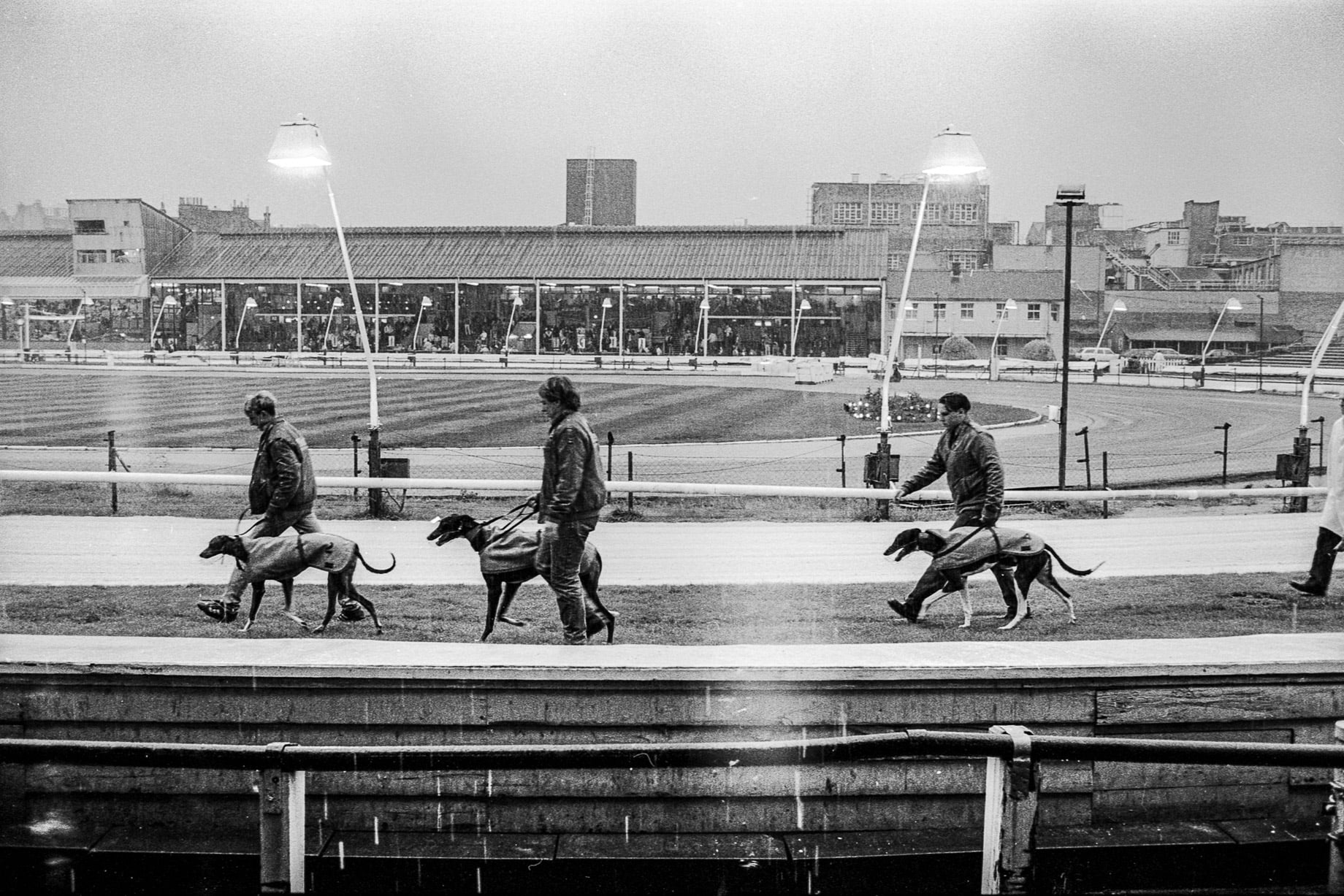
From the Graham MacIndoe Archive, University of Edinburgh Heritage Collections | www.grahammacindoe.com
Sitting on the southern bank of the Water of Leith, the Powderhall track was lined by bookmakers in the postwar era, with punters gathered in the smoke-filled stands as the announcer’s voice boomed across the stadium. One local account mentions crowds of people unable to get into the stadium gathering on a bailey bridge that once connected a path from McDonald Road to Powderhall, listening in on the races.
Walking around the area today, there are very few signs of the greyhound track that once stood here. The last race was held in January 1995, marking almost 70 years of racing. After the closure the land was sold for housing, and demolition began soon after. Ironically, in the green spaces between the modern stone flats and terraced houses, signs have been put up asking people to keep their dogs on a lead.
The end of the gradual decline in the sport, which began in the 1960s, was marked by the closure of Shawfield in 2020, Scotland’s last licensed track, and Thornton in Fife in March, which was not licensed by the sport’s regulator.
More than five years on from the last race at Shawfield, it is a shadow of its former self. Sitting dilapidated, much of the exterior has fallen into disrepair and debris is littered across the terracing. Grass has overgrown both on the pitch and in the stands, too, leaving it unrecognisable as a viable sports facility. It’s sad to see the decay as the last of Scotland’s once thriving circuit of tracks sits waiting to be demolished and redeveloped.

The stands of Shawfield stadium | Alamy
Across the UK there are now only 19 operational tracks licensed by the Greyhound Board of Great Britain (GBGB), the sport’s regulator. In Scotland, there are fewer than 20 licensed greyhound trainers left – a small group of mainly men who make the journey down to the north of England each week to race at tracks like Sunderland, Newcastle, and Star Pelaw in Chester-le-Street. Take a look online and you’ll find Facebook groups dedicated to the old Scottish tracks are filled with death notices of well-loved characters. In Scotland, it feels like the once-loved sport has been reduced to a few dwindling embers.
And the final nail in the coffin may not be far away. In April, Scottish Green MSP Mark Ruskell introduced the Greyhound Racing (Offences) (Scotland) Bill, which aims to ban the sport in Scotland due to concerns over animal welfare.
The legislation specifically targets racing on oval tracks, which is standard in the sport, and would allow the Scottish Government to regulate and potentially ban racing on other track types, such as straight tracks. Proposed penalties under the bill range from fines to imprisonment, as well as placing bans on ownership or working with greyhounds. However, it does have practical limitations. It will not prevent Scottish-based trainers from racing greyhounds in England, where there are no plans to ban the practice.
Following steps taken by members of the Welsh and New Zealand parliaments to pursue banning greyhound racing, Ruskell argues that greyhound racing inherently risks injury or death to dogs, citing GBGB data from 2023 that reported 109 trackside deaths and 4,238 injuries across the UK in 2023. He has added that he believes that existing welfare measures are insufficient and that there is no safe or humane way to force dogs to race at high speeds.

Mark Ruskell with Unbound the Greyhound Coalition and other campaigners outside the Scottish Parliament | Alamy
When he introduced the bill, he said: “With Wales and New Zealand taking action, we can’t let Scotland fall behind the pack.
“If we are a nation of dog lovers, then we need to back that up with words and deeds and deliver real protections.”
It has been an issue that has been under examination by the Scottish Parliament’s Rural Affairs and Islands Committee since 2022, responding to a petition by campaign group Scotland Against Greyhound Exploitation.
In March 2023, following a request by the committee, the Scottish Animal Welfare Commission (SAWC) published its report on the welfare of greyhounds used for racing in Scotland. It concluded that the risks of poor welfare outweigh any potential benefits of greyhound racing and injuries, especially on curved tracks, were a major concern due to the high-speed collisions and stress on dogs’ bodies.
It recommended that there be no new development of any new greyhound racing tracks and every race should have an independent veterinarian present, with the authority to prevent unfit dogs from racing and to provide immediate care, something that is required at all licensed tracks. It also suggested that a new regulatory framework, independent of GBGB, should be established. The SAWC report also suggested a phased end to the sport would be “desirable”. The report has become a key piece of evidence supporting Ruskell’s bill.
And with there being no viable option for racing in Scotland, the bill will mark the symbolic end to the sport in Scotland as it nears its centenary year. In September, agriculture minister Jim Fairlie wrote to Ruskell confirming that the Scottish Government now supported the general principles of the legislation, despite Scottish ministers having previously stated they were not “convinced” a ban was necessary.
For the few trainers who are still operating in Scotland, it’s clear that they plan to carry on despite the legislation. And as you speak to the trainers, it’s easy to understand why, despite the apparent changing of opinion on the sport. George Stark, Scotland’s biggest trainer, who trains 36 dogs at a time, has it in his blood, having been introduced to it at an early age by his dad, who raced at smaller independent tracks around the country.
A fairly young trainer at 37, Stark started attending races in Armadale and Wishaw in the 1990s. “My dad liked to gamble. Back then, there was a whole line of bookmakers at the racing, now there’s very few.
“It was booming back then; the tracks were busy. Obviously, Scotland had a lot of mining villages and greyhound racing was really a sport for the working class. In the areas around me loads of people kept greyhounds, but now it’s just me.”
Based in Lanark, Stark has been a full-time trainer for around a decade. But, he explains, “you don’t do this if you want to make a lot of money”. It’s a 24/7, 365-days-a-year job. On non-race days, he cleans out the kennels in the morning from six to 10, then he begins preparing around 40 portions of dinner for his dogs. Dinner is a long process. He shows me on his phone how he made yesterday’s dinner. The meal consists of dog biscuits, pasta, soup, and beef. It’s the dogs’ only meal of the day, but it’s a big one.
He pushes back on the people who say his dogs are “fed rubbish”. “They wouldn’t race if we fed them rubbish.”
The rest of the non-racing day is taken up by grooming and muscle recovery. This consists of magnetic therapy treatment and four massages a week.
He races three days a week in Sunderland. A normal race day consists of waking the dogs a bit earlier than usual. The day’s runners are taken out and put in pens, they clean themselves and are brushed. They leave Lanark in Stark’s van at 6.20am and begin the weighing process at 9am. They are then seen by the track vet, who checks their muscles and joints, and they’re given water and a small amount of food, usually biscuits, and wait to race.
Fifteen minutes before the race begins, Stark gets the dog ready, putting its jacket and muzzle on, and during this time of the year, an overcoat too. They arrive home at five at night and have their dinner.
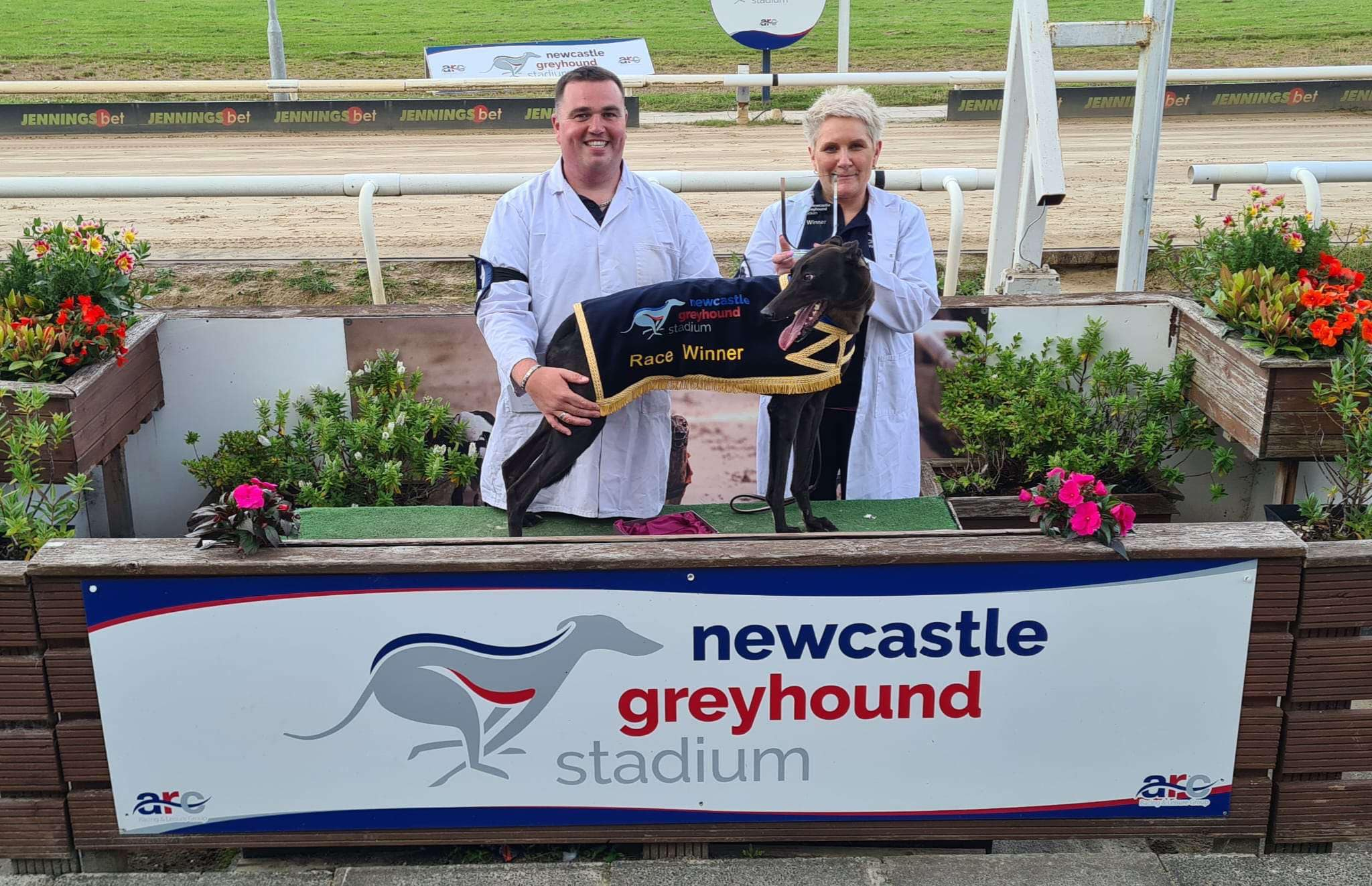
George Stark and kennel hand Tina Robinson with winner Sadie | George Stark
It’s clear this is a labour-intensive job for Stark and his dogs, but he is keen to dispel suggestions from some campaigners that trainers force their dogs to race, and he’s open to letting people see the conditions he keeps his dogs in.
“We can’t force them to do anything. If they’re not going to chase the hare, there’s nothing you can do.
“As they get older, they slow down, and maybe they don’t have as much heart. Some people say they should have 100 races and then they should be retired, but it depends on the dog. I’ve had some that have had 200 races. It depends on whether the dogs get excited to go racing.”
Ian Foster, former practitioner director of the GBGB, an owner of racing greyhounds for over 40 years, a former bookmaker, and broadcaster, knows everything there is to know about the sport, having seen it from so many angles.
He argues that the breed is by nature a hunting dog. He points to it gaining early notoriety during the reign of King Edward III for its hunting prowess, often accompanying monarchs during hunts in Windsor Great Park.
“It’s not cruel at all [to race greyhounds]; you’re enabling an animal breed for a purpose to do what it loves. That cannot be considered as cruel,” Foster says.
However, he does not deny that the sport has fallen far from the days when it was culturally significant. Having once been a bookie, he remembers when 30,000 people would attend track meets and his colleagues would line the oval track ready to offer competitive odds to those punters who wanted to make a bet.
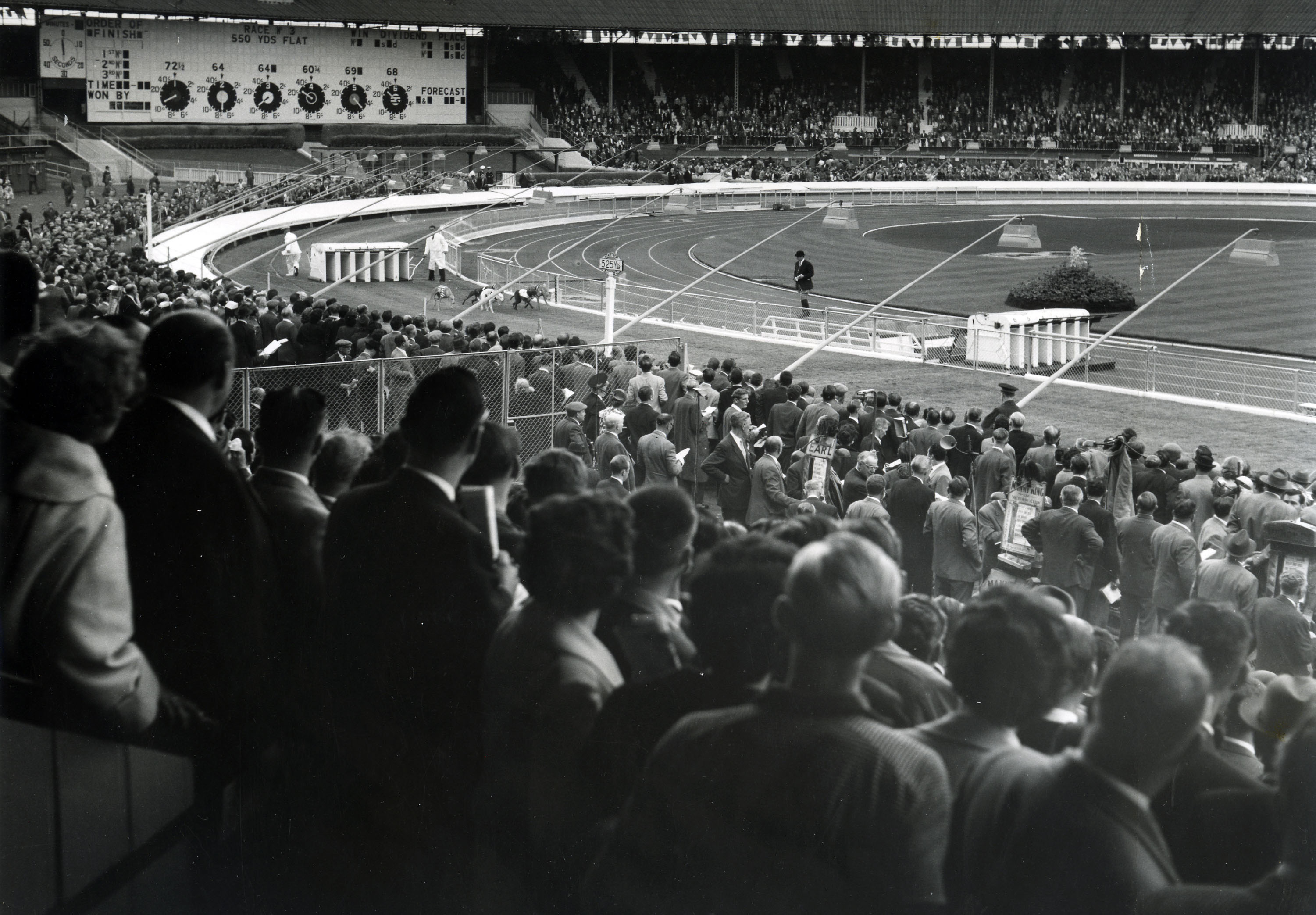
Greyhound racing at White City Stadium, London, in the 1960s | Alamy
But he says, gradually over time, more options for entertainment became available, and “greyhound racing seems to be the thing that suffered worst from it”.
“The older generation who liked to go dog racing with a pocket full of fivers are dying out, and they have not been replaced; it’s not something young people want to do. They may go and watch the dogs, buy a meal, have a pint, but there aren’t many who want to go to the bookmakers – that generation has gone, completely gone.”
With that, and the advent of online betting, Foster says he has seen tracks with as many as eight bookmakers just decades ago, reduced to just one, and largely that one is symbolic, placing most of the bets they take in person online.

Bookmakers lining the track at Walthamstow Stadium, London | Alamy
It seems those keeping the sport alive are doing so not as a financial decision, but as custodians of a tradition they believe is worth carrying on. Stark tells me that without support from his parents it would be hard to do what he does full time, and considering the near irrelevant in-person betting markets on race day that Foster describes, along with long-term declining footfall figures and the veterinary costs made mandatory by the GBGB which is paid for the track owner, this is a sport that is being kept alive through people’s passion.
Now based in Edinburgh, Foster says his support for keeping racing alive in Scotland comes from “his love of the breed”. He is concerned the ban would mean “Scotland would lose something that is part of the national heritage”.
“Nobody should be under any illusions, if the sport gets banned altogether, the breed of greyhound will be gone within 10 years, because nobody is going to breed greyhounds for anything other than racing.
“Why the people who want to get rid of the sport want to get rid of a breed of dog, I can’t really get my head around. The people who want to shut it down really don’t know in any detail what they are talking about, and whilst I think most of them mean very well, an awful lot of them are virtue signalling.
“And it would be absolutely devastating to lose something – not just financially important, but culturally important – to virtue signalling.”
The groups campaigning for the ban, however, are clear on why they want to see the sport outlawed. Unbound the Greyhound, a coalition of animal welfare organisations, has been calling on the Scottish Government to ban greyhound racing, arguing that the injury and death statistics published by the GBGB underline the danger to the dogs’ welfare.
According to figures published by the industry regulator, there have been 3,957 deaths and 35,168 injuries recorded across GBGB tracks between 2017 and 2024. In 2024 alone, 346 deaths were reported, and of those, 123 died as a direct result of racing on a track.
And while the injuries can range anywhere from a stubbed toe to the most severe type of injuries, such as a broken back, the coalition group argues racing “itself is inherently harmful and that’s due to the risk of injury and deaths”.
Eve Massie Bishop, head of campaigns and media at OneKind, one of the organisations making up the Unbound the Greyhound coalition, says last year marked an increase in greyhound deaths for the first time in two years, despite there being fewer runs in 2024.
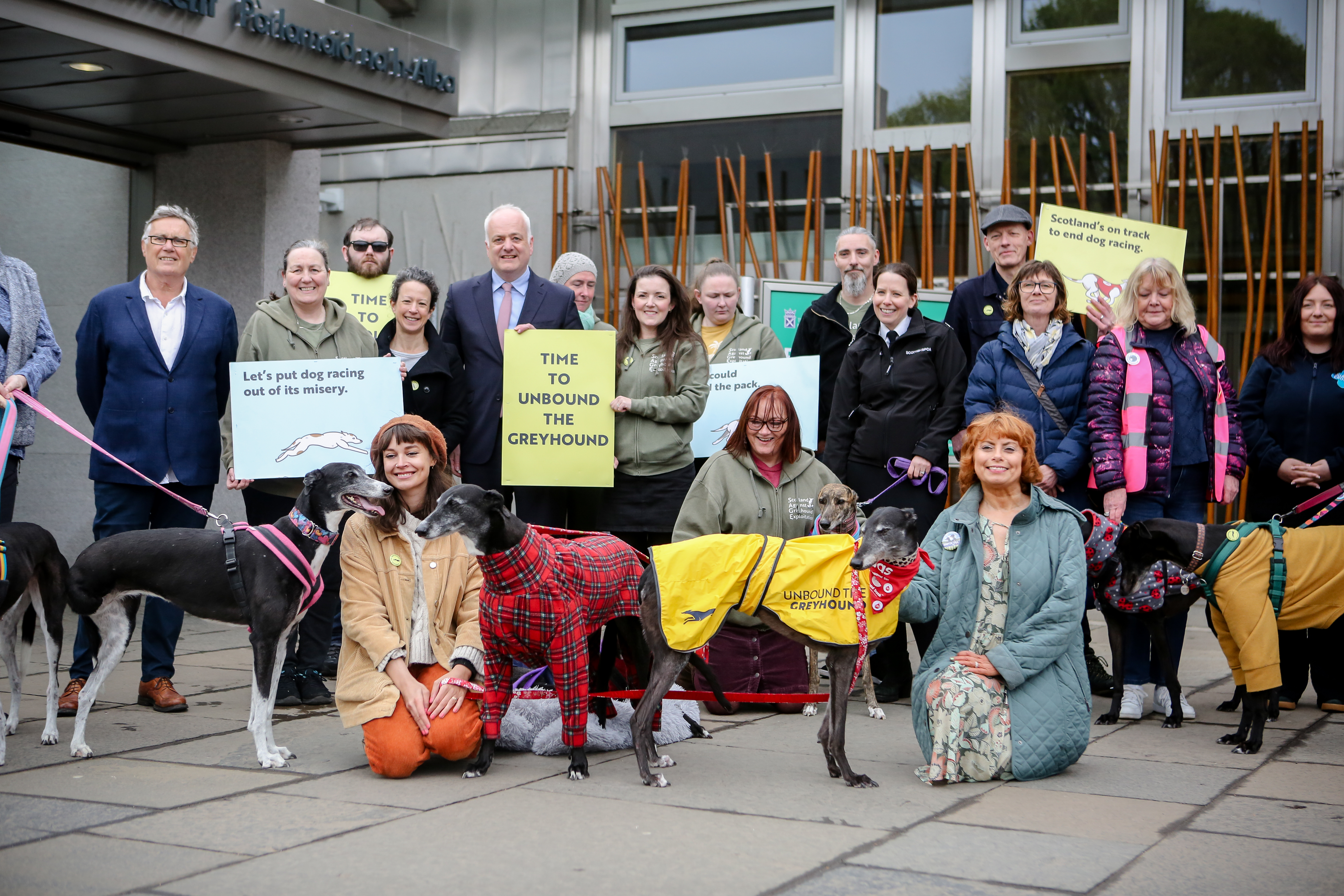
The Unbound the Greyhound coalition outside the Scottish Parliament | OneKind
Aside from the very obvious risk of injury and death, Massie Bishop says that “these dogs suffer off the track too”.
“We’re concerned about kennelling. Dogs that are raced are made to spend up to 95 per cent of their day in kennels, and some can be constantly muzzled because they tend to be kept in pairs.”
She also raises the issues of doping in the sport. In 2019, at Shawfield Stadium, five dogs were found with cocaine in their system, and notably, drug testing only occurred in less than two per cent of dogs at the Glasgow venue.
Massie Bishop adds: “Some of these dogs will have long-term issues after retirement. My own greyhound is classed as having a severe case of separation anxiety. Other dogs will have other psychological issues.”
Suzanne Simpson, chair of the Scottish Greyhound Sanctuary, has been involved in the rehoming of retired greyhounds since 2009. She says a number of greyhounds that the charity has been involved with recently have come with long-term issues related to their racing career.
Visiting Simpson at her home in a leafy suburb of Aberdeen, I am greeted by her very lovely and quite docile retired greyhound, Dudley. “He’s particularly big, he’s around 50kg,” she tells me after he falls asleep next to us.
Simpson tells me the charity has rehomed over 1,000 greyhounds since 2008. But that number pales in comparison as she tells me that Dudley comes from a champion racer in Ireland (where greyhound racing has shown no signs of slowing down, and much of the breeding takes place) which is believed to have sired between 1,800 to 2,000 pups due to extreme levels of artificial insemination.
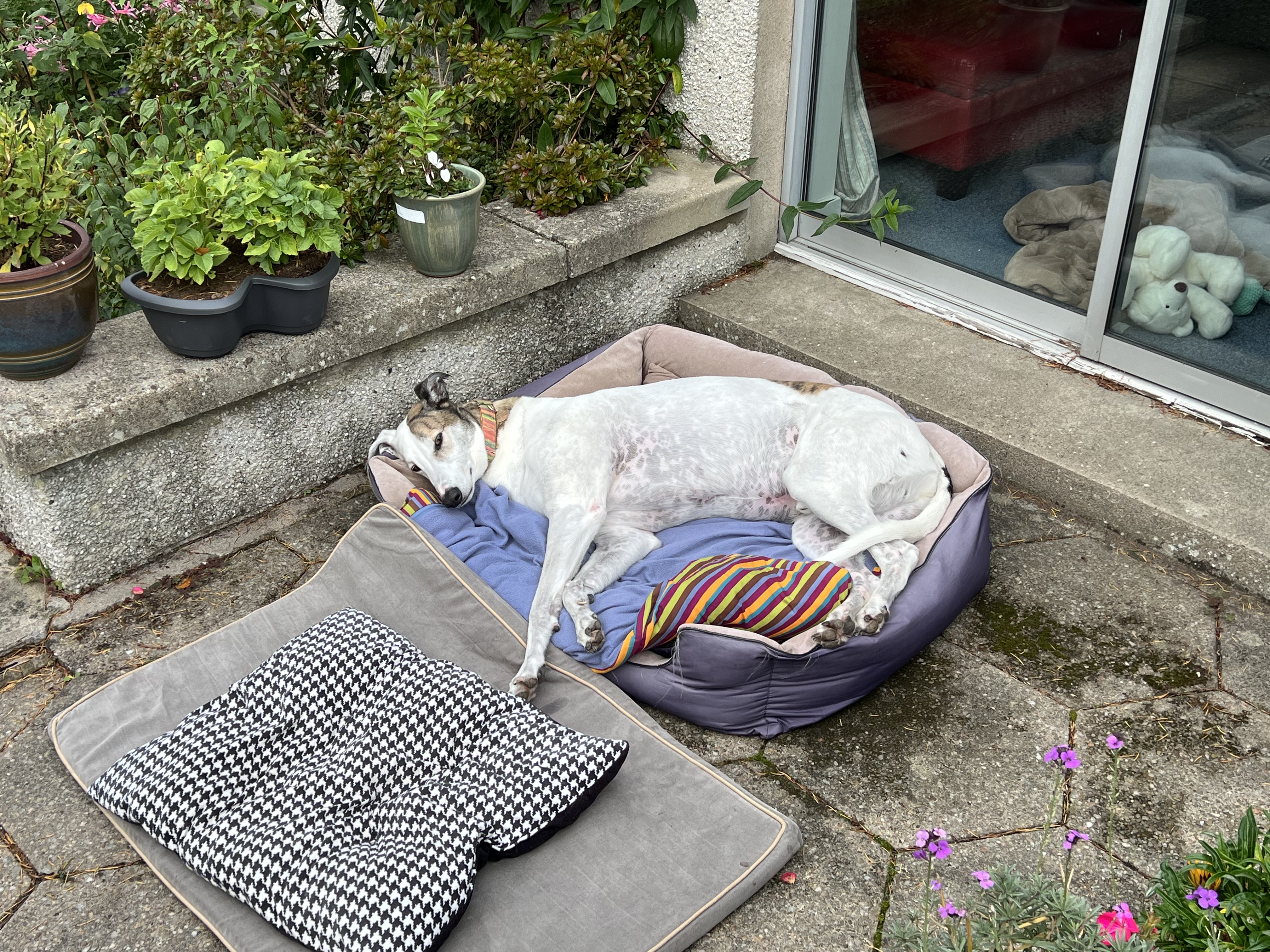
Suzanne Simpson's greyhound Dudley | Holyrood
“Folk say that the breed will die out with the racing, but the majority are being bred in Ireland. And you know that because they have tattoos on both of their ears. The reality is it’s branding; it happens when they are pups, it’s pretty brutal really.”
She’s keen to point out, despite having taken in greyhounds that have been subjected to substandard conditions like living in a small shed with little room to move for years on end and muzzled 24/7, that “not all trainers are bad”.
And over the last 10 years the GBGB has brought in a raft of new animal welfare measures to improve the situation for greyhounds. In 2018, it launched the ‘Greyhound Commitment’, which set out that welfare would become the “heart” of the sport. It included an injury recovery scheme to support veterinary treatment of orthopaedic injuries sustained at racetracks, a hotline for those concerned about the welfare of the dogs, and a code of practice for the trainers and kennel staff.
The following year, in partnership with the UK Government, it announced a deal with bookmakers for additional funds, around £3m, to boost greyhound welfare with contributions tied to turnovers on greyhound racing bets.
Then, in May 2022, it announced its long-term welfare strategy of tracking the full lifecycle of all racing greyhounds from birth to retirement, as well as tracking all five domains of animal welfare: nutrition, behaviour, health, environment, and mental state.
Mark Bird, the board’s chief executive, has been at the forefront of these reforms. He tells Holyrood: “We are at a place now where the welfare and the care of those dogs have never been higher.
“I’m not complacent about that; one dog getting injured or one dog dying is one too many for us, but we also accept that within a sport that can happen.”
Despite the regulator’s positive reforms, he says it is “a red wall sport” that is under threat, a reference to the sport’s working-class identity. I ask him directly if he thinks the ban is an attack on working-class sports.
“People talk about their heritage in the sport, their fathers and grandfathers used to race dogs, that kind of thing. At the end of the day, society moves on, and there’s this social licence around whether or not just dogs should be used, but horse racing as well.
“And that’s the thing to look at – why is greyhound racing any different from horse racing? Particularly when jump racing horses are eight times more likely to be injured than greyhounds running around an oval track. And yet, at the moment, horse racing is somewhat immune to these kinds of conversations.”
However, Bird is clear that the ban on greyhound racing in Scotland “won’t end there”. “It will move on to something else, like horse racing, angling, hunting, or shooting.”
With the future of the sport in Scotland in doubt, the GBGB warned the Rural Affairs and Islands Committee during an evidence session that a ban on greyhound racing would push it underground. Already that has begun happening in the UK, Bird says, having heard reports the day we speak that two licensed kennel hands had taken part in unlicensed straight racing in a field in England.
“They get a car to pull the lure, it’s completely unregulated with no vets.”
He adds that, despite there having been no reports yet of this in Scotland, he is unaware of any dog trainers who raced at Thornton in Fife registering with the GBGB after it closed.
“You will get to a point where people realise that their dogs want to run, and the more unscrupulous people may say ‘we’ll run them up a field instead’. We don’t want people like that in our sport.”
Holyrood Newsletters
Holyrood provides comprehensive coverage of Scottish politics, offering award-winning reporting and analysis: Subscribe